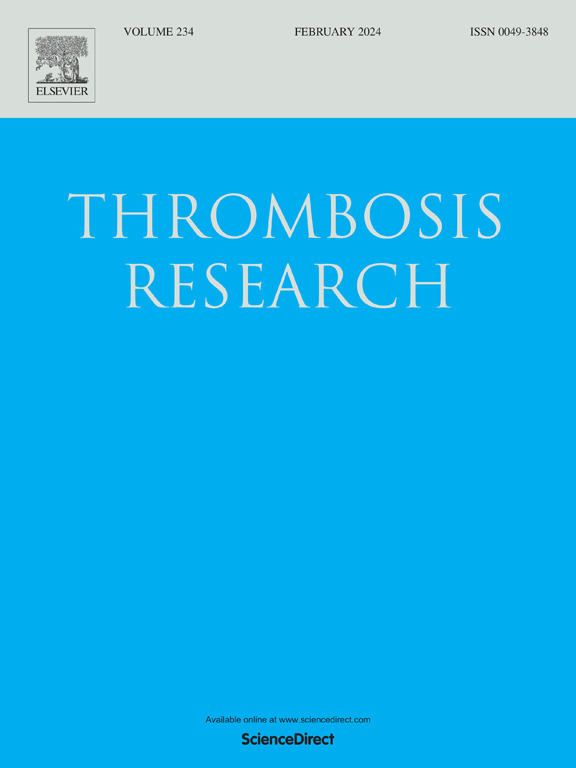老年静脉血栓栓塞患者治疗3 - 6个月后抗凝治疗的疗效和安全性:一项叙述性回顾
IF 3.7
3区 医学
Q1 HEMATOLOGY
引用次数: 0
摘要
延长抗凝仍然是静脉血栓栓塞(VTE)患者的关键考虑因素,特别是在老年人中。在这一人群中,两个主要挑战是出血风险增加和临床试验代表性不足。目前的指南建议对非诱发性静脉血栓栓塞进行无限期抗凝治疗,但出血风险高的患者除外,在这种情况下,必须仔细权衡利弊。相比之下,由短暂危险因素引发的静脉血栓栓塞,一旦该因素消退,通常不需要长期治疗。对于有慢性危险因素的患者,通常推荐无限期抗凝治疗,但应根据患者偏好、复发风险和出血风险进行个性化决策。新出现的数据强调了d -二聚体检测在指导延长治疗中的潜在作用。然而,在老年人中,d -二聚体水平可能经常因与静脉血栓栓塞无关的原因升高,从而限制了其特异性。现实世界的研究表明,在实践中存在广泛的差异,许多临床医生选择抗凝治疗超过6个月,而不管静脉血栓栓塞是否引起。最近的观察数据表明,延长治疗超过两年可能显著降低复发率,特别是在肺栓塞后,可接受出血风险。新的工具,如VTE-PREDICT风险评分,旨在通过估计5年内的复发和出血风险来支持个性化决策。然而,老年患者的出血风险评分仍然不够理想,显示出有限的预测能力。替代策略,包括低剂量doac和辅助措施,如质子泵抑制剂,可能降低出血风险。平衡复发预防和出血并发症仍然是优化延长期静脉血栓栓塞治疗的核心,特别是在老年人或合并症人群中。本文章由计算机程序翻译,如有差异,请以英文原文为准。
Efficacy and safety of anticoagulant treatment in elderly patients with venous thromboembolism beyond the first 3 to 6 months of therapy: A narrative review
Extended anticoagulation remains a crucial consideration in patients with venous thromboembolism (VTE), especially in older adults. In this population, the two main challenges are the increased risk of bleeding and the underrepresentation in clinical trials. Current guidelines recommend indefinite anticoagulation for unprovoked VTE, except in patients at high bleeding risk, where the benefits and risks must be carefully balanced. In contrast, VTE triggered by a transient risk factor typically does not require prolonged treatment once the factor has resolved. For patients with chronic risk factors, indefinite anticoagulation is often recommended, but decisions should be individualized based on patient preference, risk of recurrence, and bleeding risk. Emerging data highlight the potential role of D-dimer testing in guiding extended therapy. However, in older adults, D-dimer levels may be frequently elevated for reasons unrelated to VTE, limiting its specificity. Real-world studies show wide variability in practice, with many clinicians opting for anticoagulation beyond six months regardless of whether the VTE was provoked. Recent observational data indicate that extended therapy beyond two years may significantly lower recurrence rates, especially following pulmonary embolism, with acceptable bleeding risks. New tools, such as the VTE-PREDICT risk score, aim to support personalized decision-making by estimating both recurrence and bleeding risks over 5 years. Nevertheless, validated bleeding risk scores in older patients remain suboptimal, demonstrating limited predictive power. Alternative strategies, including low-dose DOACs and adjunctive measures such as proton pump inhibitors, may reduce bleeding risk. Balancing recurrence prevention against bleeding complications remains central to optimizing extended-phase VTE treatment, particularly in elderly or comorbid populations.
求助全文
通过发布文献求助,成功后即可免费获取论文全文。
去求助
来源期刊

Thrombosis research
医学-外周血管病
CiteScore
14.60
自引率
4.00%
发文量
364
审稿时长
31 days
期刊介绍:
Thrombosis Research is an international journal dedicated to the swift dissemination of new information on thrombosis, hemostasis, and vascular biology, aimed at advancing both science and clinical care. The journal publishes peer-reviewed original research, reviews, editorials, opinions, and critiques, covering both basic and clinical studies. Priority is given to research that promises novel approaches in the diagnosis, therapy, prognosis, and prevention of thrombotic and hemorrhagic diseases.
 求助内容:
求助内容: 应助结果提醒方式:
应助结果提醒方式:


